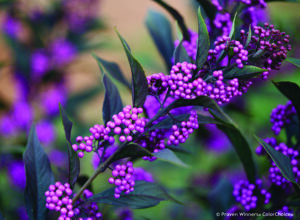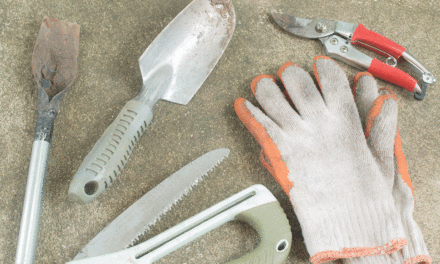
Eva Monheim describes beautyberry as “a fabulous plant.” This variety, Callicarpa ‘Pearl Glam,’ has purple leaves from the spring to frost and purple berries through the winter. (Photo courtesy Proven Winners)
With typical uses of concealing a foundation, creating privacy along a property line or stabilizing a slope in the yard, shrubs and hedges can quickly get stuck waiting in the wings rather than featured in the limelight of a landscape.
But in their supporting roles, there is a lot of variety, according to Eva Monheim, an award-winning horticulture educator and author, and selecting them for color and function should not be taken lightly.
“The front doors and picture windows of millions of houses world-wide are adorned by shrubs. Despite their ubiquity, selecting and maintaining shrubs remains a mystery to many. Shrubs are all-too-often inappropriately pruned into “meatball” shapes, or alternatively, left to become an overgrown tangle of branches,” Monheim says on her website, evamonheim.com. “It’s time for shrubs to take center stage.”
Drawing from a list of more than 130 shrubs, Monheim discussed shrubs for multiple applications, during a recent Pennsylvania Horticultural Society GROWinar, “Selecting Shrubs for Four Seasons of Interest,” pointing out many that go underutilized or unused altogether.
“We need to rethink how we look at the landscape,” she said
More diversity in the garden, can cut down on deer damage, she said, “so there’s less chance of mass annihilation of one plant.”
She urged gardeners to take a notebook when visiting a garden center, where they can see plants in bloom. If you can’t buy a plant right away, take notes so you can do some research and come back to buy it later.
She started with shrubs with fabulous fall color, including chokeberry, witch-hazel, yellowroot and viburnum. Several varieties of sumac made her list, from two kinds of Staghorn sumac to shiny or winged sumac and another fragrant variety called ‘Gro Low.’ Sumac is a native shrub you see growing along roadsides.
“It’s important because of erosion control. It has amazing tenacity on a slope and fall color beyond words,” Monheim said. It’s foliage is very tropical. Sumac does sucker, she added, so you might plant a “well-behaved” plant underneath it like yellowroot.
She described beautyberry as “a fabulous plant.” This shrub was used by Native Americans as a classic medicinal. In addition to fall color, as its name implies, the plant has beautiful berries that remain on the plant through the winter. Its long stalks make a good cut berry for flower arranging. There are purple and white varieties. “Most of these are deer proof,” Monheim said. “There are certain textures — sandy, gritty, fuzzy — that deer do not care for.”
Euonymus, on the other hand, is a deer favorite that Monheim said is overused. The hooves of deer vibrate the ground, which encourages the plant to push up new growth, which the deer come back to graze on. The variety she chose as an illustration was euonymus americana, or hearts-a-bustin’, which produces bumpy pinkish-red capsules that split open to reveal the orange-red seeds.
First on the list of plants for winter interest was Winterberry holly. Holly is a northern plant, so its fruit ripens early. Maryland Beauty, however, is a native put into cultivation and its berries ripen later. Red Sprite ripens earlier, and at a maximum of 3 to 4 feet, makes a nice hedge. Winter Gold is a heavy fruiter. Birds eat its gold and white berries later.
Monheim loves Dragon lady holly. Deer don’t like this sharp and spiny plant, which is a non-native cross.
“Use it to protect the inside of your garden rather than fencing,” she suggested.
Nandina is beautiful, but can be an aggressive spreader. “I recommend putting them in a pot,” Monheim said. Its berries have cyanide in them, which can kill birds. “I recommend nipping off the berries if it’s a sparse winter,” she added.
One of Monheim’s favorites is gold-thread Japanese falsecypress, ‘Filifera Aurea’ if it’s not sheared. “I love it because it hangs like threads, a dancing figure in the garden,” she said. This evergreen can grow to 20 feet.
Other winter favorites include camellia, vernal witch-hazel, Mahonia, japanese pieris and white forsythia.
Spring favorites include fothergilla, spicebush, Virginia sweetspire, rhododendron and azaleas. “I love the early Korean rhododendron,” she said.
Japanese kerria presents a breathtaking scene, Monheim continued. In its native Japan, it is used to prevent erosion.
There has been a lot of research in the plant industry on flowering quince, producing flowers ranging from whites to pink, coral or deep red. Quince was once popular on farms because the fruit was made into jam which was used to marinate pork products.
Along with familiar sweetshrub, mountain laurel, fringe tree and serviceberry, Monheim described two “underused” shrubs, enkianthus and zenobia. Enkianthus perulatus ‘J.L. Pennock’ has very white, bell-shaped flowers and great fall color. A member of the heather family, enkianthus was popular in the 1930s to 1950s.
Dusty zenobia or ‘Woodlanders Blue’ has multiple bell-shaped flowers.
Planted at Longwood Gardens by a stream, it has taken off, she said, and deer don’t bother this native.
For many gardeners, few plants beat hydrangeas, visually, for summer bloom. New cultivars are being developed, such as ‘Mini Mauvette’ that have thicker stems that don’t flop over like Annabelle.
Endless Summer, released by Bailey Nurseries, “changed the world when it comes to macrophylla,” Monheim said. It blooms on old and new wood. There are many improved variations of this bigleaf hydrangea from Bailey.
A smooth hydrangea, Invincibelle Ruby from Proven Winners, is one you can cut and it will produce more flowers the same season.
Summersweet clethra or sweet pepperbush is a sweet-smelling, pollinator attractor. ‘Hummingbird’ stays low where the regular species grow to 8 feet and is more gangly. ‘Ruby Spice’ has reddish pink flowers.
Other summer “staples and sensations” include glossy abelia, bottlebrush buckeye, Double Knock Out rose, crape myrtle and smokebush.
Monheim’s latest book, “Shrubs and Hedges: Discover, Grow, and Care for the World’s Most Popular Plants,” was released in March.
PHS Vice President of Public Horticulture, Andrew Bunting who co-hosted the GROWinar, said because of COVID-19, PHS has taken almost all its programs and turned them into webinars. Upcoming offerings can be seen at https://phsonline.org/events.




